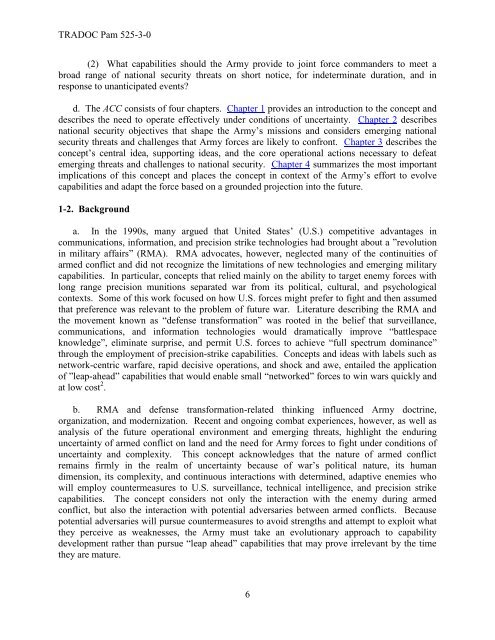(Pam) 525-3-0, The Army Capstone Concept - Federation of ...
(Pam) 525-3-0, The Army Capstone Concept - Federation of ...
(Pam) 525-3-0, The Army Capstone Concept - Federation of ...
Create successful ePaper yourself
Turn your PDF publications into a flip-book with our unique Google optimized e-Paper software.
TRADOC <strong>Pam</strong> <strong>525</strong>-3-0<br />
(2) What capabilities should the <strong>Army</strong> provide to joint force commanders to meet a<br />
broad range <strong>of</strong> national security threats on short notice, for indeterminate duration, and in<br />
response to unanticipated events?<br />
d. <strong>The</strong> ACC consists <strong>of</strong> four chapters. Chapter 1 provides an introduction to the concept and<br />
describes the need to operate effectively under conditions <strong>of</strong> uncertainty. Chapter 2 describes<br />
national security objectives that shape the <strong>Army</strong>’s missions and considers emerging national<br />
security threats and challenges that <strong>Army</strong> forces are likely to confront. Chapter 3 describes the<br />
concept’s central idea, supporting ideas, and the core operational actions necessary to defeat<br />
emerging threats and challenges to national security. Chapter 4 summarizes the most important<br />
implications <strong>of</strong> this concept and places the concept in context <strong>of</strong> the <strong>Army</strong>’s effort to evolve<br />
capabilities and adapt the force based on a grounded projection into the future.<br />
1-2. Background<br />
a. In the 1990s, many argued that United States’ (U.S.) competitive advantages in<br />
communications, information, and precision strike technologies had brought about a ‖revolution<br />
in military affairs‖ (RMA). RMA advocates, however, neglected many <strong>of</strong> the continuities <strong>of</strong><br />
armed conflict and did not recognize the limitations <strong>of</strong> new technologies and emerging military<br />
capabilities. In particular, concepts that relied mainly on the ability to target enemy forces with<br />
long range precision munitions separated war from its political, cultural, and psychological<br />
contexts. Some <strong>of</strong> this work focused on how U.S. forces might prefer to fight and then assumed<br />
that preference was relevant to the problem <strong>of</strong> future war. Literature describing the RMA and<br />
the movement known as ―defense transformation‖ was rooted in the belief that surveillance,<br />
communications, and information technologies would dramatically improve ―battlespace<br />
knowledge‖, eliminate surprise, and permit U.S. forces to achieve ―full spectrum dominance‖<br />
through the employment <strong>of</strong> precision-strike capabilities. <strong>Concept</strong>s and ideas with labels such as<br />
network-centric warfare, rapid decisive operations, and shock and awe, entailed the application<br />
<strong>of</strong> ‖leap-ahead‖ capabilities that would enable small ―networked‖ forces to win wars quickly and<br />
at low cost 2 .<br />
b. RMA and defense transformation-related thinking influenced <strong>Army</strong> doctrine,<br />
organization, and modernization. Recent and ongoing combat experiences, however, as well as<br />
analysis <strong>of</strong> the future operational environment and emerging threats, highlight the enduring<br />
uncertainty <strong>of</strong> armed conflict on land and the need for <strong>Army</strong> forces to fight under conditions <strong>of</strong><br />
uncertainty and complexity. This concept acknowledges that the nature <strong>of</strong> armed conflict<br />
remains firmly in the realm <strong>of</strong> uncertainty because <strong>of</strong> war’s political nature, its human<br />
dimension, its complexity, and continuous interactions with determined, adaptive enemies who<br />
will employ countermeasures to U.S. surveillance, technical intelligence, and precision strike<br />
capabilities. <strong>The</strong> concept considers not only the interaction with the enemy during armed<br />
conflict, but also the interaction with potential adversaries between armed conflicts. Because<br />
potential adversaries will pursue countermeasures to avoid strengths and attempt to exploit what<br />
they perceive as weaknesses, the <strong>Army</strong> must take an evolutionary approach to capability<br />
development rather than pursue ―leap ahead‖ capabilities that may prove irrelevant by the time<br />
they are mature.<br />
6
















